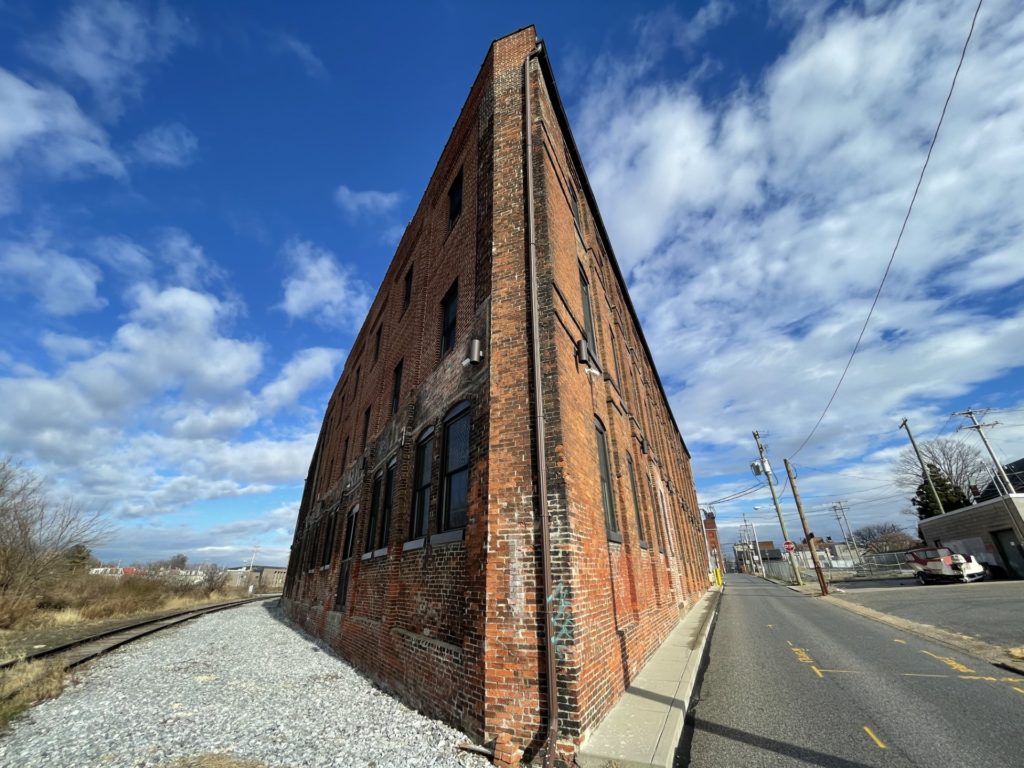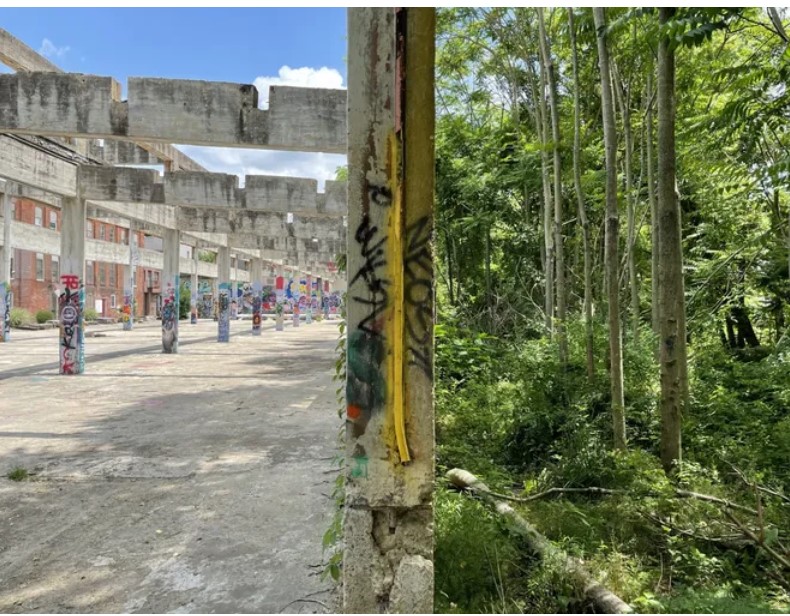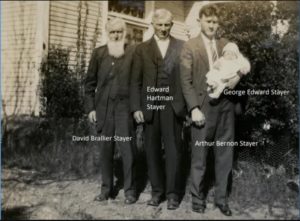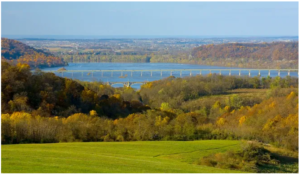Recreationists & creatives resilient economic influencers
Keystone Color Works
175 West Gay Avenue, York Pa.
The situation
The picture below shows a triangular building in, yes, the Northwest Triangle, a three-sided plot of land forging a bend in the Codorus Creek. This land signals much — including what stood there before redevelopers took over. There were tall grain silos, indicative of a perhaps forgotten piece of York’s past. The city was the foremost agricultural market center in the York County from its beginning as a village in 1741. A gas station was leveled, too, a relic of the day that service stations operated all over York city. They’d knock down landmark buildings to create space for the fillups needed to keep the automotive culture rolling, with a priority on parking lots. That’s the past.

The former Keystone Color Works, now Color Works Apartments.
But the red-brick building, with its unclosed third angle and dating from the Industrial Revolution, explains something going on in the present: a combination of creatives in studios and recreationists on trails that provides energy to a city and a county.
Actually, more than energy. An ongoing economic boost — drivers, as they’re called. And since we’re dealing in threes, no doubt some of the renters who live in the restored Keystone Color Works or Color Works Apartments are among the creatives (or their customers) and recreationists.
How can one restored building illustrate both creatives and recreationists? Keystone Color Works opened operations in old railroad shops on this site in 1919 and some years later produced chemical pigment colors for wallpaper companies. Colorful dyes, that is. The artists and printers at places like York Wallcoverings used Keystone wallpaper colors in their beautiful products. That covers the creatives. As for the recreationists, the York County Heritage Rail Trail runs just to the west of the building and nearby railroad tracks. Indeed, the last short stretch of the rail trail was completed earlier this year just to the north of the building. The Golden Spike connected two stretches of the rail trail, binding them into one 27-mile ribbon.

Oh, there’s one more point of meaning to squeeze from the building. A stylized painted finger that somehow seemed out of place in a heavy industrial complex directs past employees to an office, an art piece in its own right.
+++
While on the topic, we’ll point to another photo that signals creatives and recreationists. This shows Glen Rock’s Ruins Hall, what’s left of a building that was part of Enterprise Furniture Co. and successors, where craftsmen made dining room and bedroom furniture with their heads, hearts and hands. Some years ago, street artists took over this space, and the inviting, colorful scene gained renewed value, causing entertainers to adapt it as a venue.
The recreationists enter the picture in at least two ways. The rail trail runs along the railroad tracks to its left, the same path that passes the Color Works building some 15 miles to the north. Those rails also provide trackage for an excursion service, the Northern Central Railway. And to the right, well, you can see the natural state of the swath cut by the South Branch of the Codorus Creek, the greenery that follows the rail trail along much of its winsome path.
More: Ruins Hall and other Trail Towns receive big public art grant.
+++
Take your pick of the moment that the creatives and recreationists came together to provide a boost to York County’s economy and quality of life. Two years in a four-year window at the turn of the millennium stand out.
In 1999, the dedication of the Heritage Rail Trail – then known as the Codorus Bike Path – and its completion from the Maryland line to York came as part of festivities marking the 250th anniversary of York County. In that same celebration, Yorkfest, a three-day music festival at Lafayette Plaza next to the trail, and the Riverwalk Arts Festival, a two-day event hugging the trail, provided a confluence of creatives and recreationists.
Three years later, urban planner David Rusk drafted the Rusk Report 2.0 that called for a productive climate for creatives in York County – development different from its bricks and mortar past. A quote from Carnegie Mellon’s Richard Florida appeared in the report providing a remarkable forecast of what an environment for creatives — and recreationists — could look like. And is moving toward today:
“While it is important to have a solid business climate, having an effective people climate is even more essential. By this I mean a general strategy aimed at attracting and retaining people — especially, but not limited to, creative people. This entails remaining open to diversity and actively working to cultivate it, and investing in the lifestyle amenities that people really want and use often [urban parks, bike lanes, performance venues], as opposed to using financial incentives to attract companies, build professional sports stadiums, or develop retail complexes.”
So we have two sites, Color Works Apartments and Ruins Hall, relics of the Industrial Revolution initially tromping over natural settings. And today, the combination of creatives and recreationists has produced a reuse that trumps demolition of these post-Civil War buildings, offering these sites from a day before yesterday a future.
And these two pictures carry creation and recreation stories of their own. They were exhibited at the Gallery at the Old Post Office in Hanover earlier this year, captured when a creative, journalist/photographer Joe McClure, was hiking around York and Glen Rock.
The witness
Five pieces are excerpted here assessing the creative and recreationist scenes in York County:
Cultural Alliance’s Kelley Gibson and Economic Alliance’s Silas Chamberlin, writing in a guest column in the York Sunday News in 2022:
“York County’s creative and outdoor sectors collectively employ more than 8,000 York County residents and are resilient drivers of York County’s economy that have grown in employment by 30% in the last decade alone. We need a more robust infrastructure to invest in our arts, cultural and outdoor amenities and the organizations that support them, so we can grow their economic impact even further.”
More: York County’s cultural and outdoor sectors are economic drivers (ydr.com)
+++
David Rusk, writing in 2002, called for York County to create a community that would attract, grow and retain such a creative class, who would contribute alongside workers in industry, agriculture and services. He put forth this example about York:
“Think of York County’s economy as if it were an athlete — a middleweight weightlifting champion, bulked up from hoisting all those York barbells at a gym just down the road from the National Weightlifting Hall of Fame. York’s been successful for years at what it does well — pumping iron. But it’s losing a little muscle tone. And it sees the big money going not to weightlifters but to sprinters and milers — that is, creative class economies.”
More: Rusk reports 1, 2 and 3 (ydr.com)
James McClure, one of the writers of this WitnessingYork.com piece, in a guest column in the York Sunday News, 2023:
“The work and life of the creatives can be seen around the city and county. You can look through old store fronts and see young professionals writing digital code. You can see the creatives participating in evenings of storytelling, often about life in York County. You can find creatives at work in downtown Hanover, where at least two art galleries operate. And in Ruins Park in Glen Rock, you’ll find an increasingly popular site that combines art with an outdoors event venue.” More: York County Pa. creatives provide vital arts element to community life (ydr.com)
+++
Kelley Gibson, responding to McClure’s guest column:
“In the recent column published in the York Sunday News titled ‘York County creatives provide vital arts element to community life,’ author Jim McClure highlights the measurable growth of arts and culture in York, and traces that growth back to a recommendation by Urban Planner David Rusk in his 2002 ‘Rusk Report’ to revitalize our county and urban core by growing our creative class. Jim notes in his piece that this growth is in spite of our community not implementing Rusk’s recommendations to fund it with public tax dollars. So how did we get here? It’s not a coincidence; several key investments have built York County into an attractor of the creative class.”
More: Here’s how creatives have help revitalize York, Pa. (ydr.com)
+++
Susquehanna National Heritage Area’s Mark Platts, about the Cuff’s Run pump storage hydro project, a project that has since been abandoned. Platts shows how the new economy based on recreation is replacing the old.
“With all of the investment over the past 20 years in making the river a more attractive destination for local residents and heritage and outdoor travelers, it’s really distressing to see such an old-school proposal like this one be revived once again (fourth time in 50 years).
“The Susquehanna Riverlands of York and Lancaster counties are a conservation landscape now, not a development landscape. The future is heritage tourism, outdoor recreation, river towns revitalization and small business development, not massive, man-made impoundments that flood woodlands, farms, homes, hiking trails and historic landscapes to generate power that uses more energy than it produces simply for higher corporate profits, and then sends it out of state with little value to Pennsylvanians.
“It will actually produce fewer permanent jobs than local heritage and conservation groups have already created in just a few years by focusing on preservation instead of more industrial-scale development.
“Imagine if we instead invested the $2 billion proposed for this project in more land protection, historic preservation, parks, trails and community revitalization efforts. Now that would be true sustainable economic development and make this an even more desirable place to live, work and play than it already is!”
More: Recreationists discovering beauty on Susquehanna and along its banks (ydr.com)
The questions
Jim McClure and Kelley Gibson both note the growth of creative enterprises in our county, despite not using tax dollars. They remark that it took coordinated efforts from key investors. What are your thoughts on York County’s climb out of an economic slump and into a playground for recreationists and creatives? How did we get here?
Related links and sources: Rusk reports 1, 2 and 3 (ydr.com); Keystone Color Works: A Historic Structure that goes back to 1873. Photos by Joe McClure, except directional painting, courtesy of York Daily Record. Note: Joe McClure is Jim McClure’s son. Lorann Jacobs is Jamie Noerpel’s grandmother.
— By JAMIE NOERPEL and JIM McCLURE




